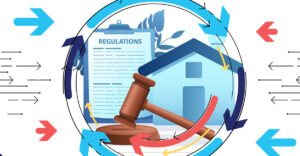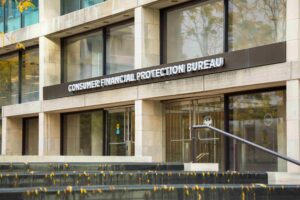Enacted into law on July 30, 2008, during the height of the housing crisis, the Secure and Fair Enforcement for Licensing Act, otherwise known as the SAFE Act, created a national registration of all residential mortgage originators. The legislation also established a detailed set of federal licensing requirements for all loan originators not employed at a bank, thrift or credit union, effectively creating a two-tiered national licensing system.
After more than a decade of the SAFE Act, it is clear the law has accomplished a great deal when it comes to protecting consumers. The law has advanced the professionalism and education of loan originators working in the industry. The national registration requirement has eliminated many with criminal backgrounds from the profession.
As a result, consumers have benefited from better loan quality and fewer instances of fraud. Today, licensed loan originators are better educated, more experienced and better able to provide quality services to consumers.
Some aspects of the SAFE Act, however, merit review and should be clarified or changed. First, nonbank mortgage lenders need greater clarity and consistency regarding which of their employees need to be licensed. Second, the Consumer Financial Protection Bureau (CFPB) or Congress should end the broad exemptions that loan originators at banks enjoy from the law’s requirements.
Originator definition
Each state must meet the minimum licensing standards of the SAFE Act, which requires that every mortgage originator employed by a nonbank lender or as an independent broker must pass the national SAFE Act test (measuring knowledge and ethics). They must pass an independent background check and complete at least 20 hours of approved prelicensing courses. In addition, originators need to complete at least eight hours of continuing-education courses each year.
As such, the law imposes a significant cost and compliance burden on every independent mortgage bank (IMB) or mortgage brokerage company — and on the loan originators who work for them. Therefore, the definition of who qualifies as a loan originator is vitally important.
Under the law, a loan originator is defined as an individual who takes a residential mortgage application and offers or negotiates terms of a residential mortgage in exchange for compensation. These critical tasks have been further defined by CFPB regulations.
For example, according to these regulations, a person is not required to be licensed if they collect basic identifying information about — but do not take an application from — a prospective borrower who inquired about a prequalified offer. The SAFE Act also excludes persons who perform purely administrative or clerical tasks.
There is nothing in the legislation that prevents a state from taking actions to require more than what is required in the SAFE Act. A majority of states, however, have enacted legislation to implement the SAFE Act based on the federal “model code,” which was designed to establish the required minimum standards and activities set forth in the law.
Unfortunately, in the decade that the SAFE Act has been in existence, some states that adopted the model code took differing and often more expansive constructions of what constitutes taking an application or negotiating the terms of a residential mortgage. Some recent examples of this include:
An individual taking basic information at a call center and passing such information to a licensed loan originator.
An individual taking the borrower’s information from a 1003 mortgage application and manually, in a ministerial fashion, entering such information into loan origination software.
Regulatory creep
One of the strengths of having the federal SAFE Act is that lenders operating in a multistate environment should be able to determine with clarity and consistency across these states what constitutes a loan originator for licensing purposes. Without such clarity and consistency, companies would incur significant and unnecessary compliance costs, along with diversion of personnel, in order to track emerging differences across different states and continually adapt licensing-compliance standards to any changes.
Moreover, any regulatory creep — in which states gradually broaden the definition of a loan originator — is contrary to the purposes of the SAFE Act. It is spelled out in the language of the law that it aimed to increase uniformity and reduce regulatory burden.
Another problem for lenders is that regulatory creep is often introduced in the examination process, through enforcement, and without notice to lenders — a practice that is sometimes referred to as regulation by enforcement. There is a broad consensus that this is not fair, as it can amount to retroactive fines and penalties incurred by lenders who attempt to comply in good faith but fail to conform to evolving requirements they are unaware of.
Finally, while licensing requirements for peripheral tasks and personnel increases the regulatory burden and costs, it does nothing to protect consumers, who still enjoy a basic right under the SAFE Act to work with a qualified originator who is doing most of the work on the loan for the borrower. It is therefore critical that the model code be implemented under one nationwide standard — with clarity and consistency — that lenders can rely upon in every state in which they do business.
Why allow hundreds of thousands of nonlicensed, nontested individuals to work for years as a loan originator at a bank without meeting [SAFE Act] requirements?
Differing requirements
A second and possibly more controversial point concerns the disparate licensing provisions for residential loan originators — differences that are solely based on whether the lender is a depository or a nondepository institution. Originators who work for federally insured financial institutions such as banks and thrifts, or subsidiaries of such depositories, must merely register through the Nationwide Mortgage Licensing System and Registry.
Registration entails a background check and a credit review, but no education or testing. In contrast, a loan originator working for an IMB or mortgage brokerage has a number of more stringent requirements including a SAFE Act test, a background check done by an independent party, and prelicensing and continuing-education courses.
This disparate treatment came to the forefront as Congress recently enacted transitional licensing authority. Under this new law, an originator who worked for one year or more at a bank or credit union can now go to work for up to 120 days for an IMB or a brokerage without immediately fulfilling the more rigorous requirements for nonbank originators. The only limitations is that the originator cannot have had a license denied, revoked or suspended; be subject to a cease and desist order; or have been convicted of a crime which would preclude licensure under state law.
During congressional debate on transitional licensing, there was concern about allowing a mortgage originator to work for a nonbank for a few months without being tested or taking prelicensing courses. The real question should have been: Why allow hundreds of thousands of nonlicensed, nontested individuals to work for years as a loan originator at a bank without meeting these requirements?
The CFPB has a statutory requirement under the 2010 Dodd-Frank Act to ensure that every mortgage originator is qualified. Yet there are originators working at banks right now who failed (or never passed) the SAFE Act test. How can it be that a loan originator who fails the basic test that measures mortgage knowledge is considered to be meeting the statutory requirement that they are qualified?
Moreover, the overwhelming majority of originators working at depository banks have never taken the SAFE Act test and would fail the exam if forced to take it tomorrow. Every other real estate- and mortgage-related business — as well as bank employees who sell insurance or securities — requires licensing, which includes basic testing and education. Yet mortgage originators who work at banks are exempt. Having a qualified mortgage originator has to be at least as important as having a qualified bank employee sell you shares of stock or life insurance.
●●●
The mortgage industry supported education and testing for nonbank loan originators to advance the professionalism of those dealing with consumers. There is no valid reason to not have similar requirements for loan originators working for banks and thrifts.
Until that happens, there should be clear disclosures so that a consumer knows whether the person they are working with did or did not complete these basic licensing requirements. With these modest changes, the SAFE Act can truly fulfill the mission it was created to achieve.
Author
-
Wayne Watkinson is a principal attorney at Offit Kurman and is a member of the firm’s regulatory practice group. Watkinson’s practice focuses on representing mortgage lenders and brokers in compliance, licensing and corporate matters. He began his career with the New Jersey Administrative Office of the Courts. Offit Kurman is a member of the Community Home Lenders Association (CHLA). The opinions expressed in Watkinson's article(s) are not necessarily those of Offit Kurman.
View all posts



